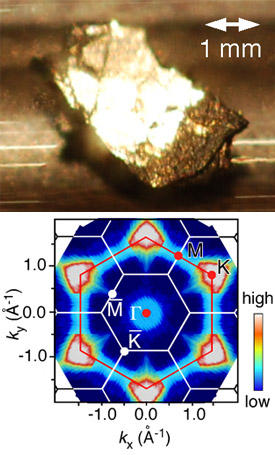

08/31/2009

The discovery of superconductivity at unusually high temperatures in the graphite intercalation compounds C6Yb and C6Ca has spurred intense efforts to understand the nature of superconductivity in these materials. Researchers from the Advanced Institute for Materials Research (AIMR) and the Department of Physics at Tohoku University1 have now contributed an important clue to the origin of superconductivity in graphite compounds by determining the size and nature of the tell-tale gap in the superconducting energy spectrum.
C6Ca is part of a larger family of layered materials in which atoms such as calcium are intercalated between graphite sheets. Some of these graphite intercalation compounds were found to be superconductive more than 40 years ago. However, the recently discovered C6Ca is special, as it remains superconductive to much higher temperatures, up to 11.5 K.
To unravel the origin of this behavior, the researchers compared the electronic states of C6Ca with those of regular graphite. They measured the small differences between these compounds using a special high-resolution photoemission spectrometer at Tohoku University. “The energy resolution of our spectrometer is world-leading and essential to observe the superconducting gap,” comments Takashi Takahashi, who led the research team.
The high-resolution experiments uncovered important differences between graphite and C6Ca. In particular, the experiments revealed not only the energetic states associated with the carbon atoms in the graphite layers, but also those of the calcium intercalation layers. The researchers were thus able to observe the changes in the interlayer energy states as the material was cooled to below the superconducting onset temperature.
The theoretical expectation was that the onset of superconductivity could be observed by the opening of a gap in the measured energy states. Indeed, this is what the researchers observed. However, the gap was seen only for the electronic states of the calcium interlayers — not for the in-plane states of the graphite sheets.
These findings provide clear evidence of the important role of the interlayer. The calcium atoms ‘donate’ electrons to the graphite layers, but the experiments also suggest that this strong coupling between the calcium electrons and the carbon atoms could explain the higher superconducting temperature of C6Ca.
The importance of these findings extends beyond the graphite intercalation compounds. The results may also provide important clues toward the understanding of other layered systems, such as the high-temperature cuprate superconductors. In addition, says Takahashi, “the knowledge we obtained may eventually also lead to the discovery of new superconductors with even higher transition temperatures.”
Sugawara, K., Sato, T. & Takahashi, T. Fermi-surface-dependent superconducting gap in C6Ca. Nature Physics 5, 40–43 (2009). | article
This research highlight has been approved by the authors of the original article and all information and data contained within has been provided by said authors.